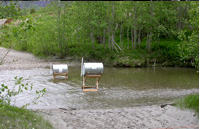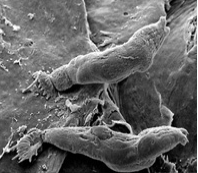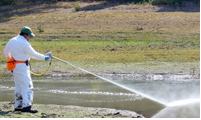Gyrodactylus salaris
Gyrodactylus salaris
One of the major threats to stocks of Atlantic salmon in the freshwater phase is the parasite Gyrodactylus salaris. It is a small parasite (0.5mm in length) infecting the skin, gills and fins of fish and is capable of rapid multiplication.
The parasite is most likely endemic to the rivers draining into the Baltic Sea but has been introduced to Norway, to Atlantic drainages in Sweden and to Rivers draining into the White Sea / Barents Sea in Russia. After its introduction to Norway in the 1970s and 1980s G. salaris caused enormous ecological and economic damage and has had a negative impact on populations of Atlantic salmon in the Russian river Keret and possibly also in rivers on the Swedish west coast.
NASCO’s goal is to prevent the further spread of this parasite and to eradicate it from infected areas, working with stakeholders, where appropriate.
‘The parasite Gyrodactylus salaris‘ (NEA(16)6), provides information on Gyrodactylus salaris, its impact on Atlantic salmon, its distribution within NASCO Parties and relevant NASCO agreements.



Gyrodactylus salaris ‘Road Map’
NASCOs North-East Atlantic Commission (NEAC) has developed a Gyrodactylus salaris ‘Road Map’. This contains recommendations to enhance cooperation on monitoring, research and exchange of information in relation to this parasite and on measures to prevent its spread.
- ‘Revised Road Map’ to enhance information exchange and cooperation on monitoring, research and measures to prevent the spread of G. salaris and eradicate it if introduced.
Reporting under the Road Map can be found in NEAC Annual Meeting Papers.
Under the ‘Road Map’, NEAC Parties and their relevant jurisdictions should have contingency plans in place for the treatment, containment or eradication of G. salaris. These are in development in several jurisdictions. The Norwegian contingency plan is available online and can be found here (in Norwegian).
Publicity Materials
The ‘Road Map’ also asks NEAC Parties and their jurisdictions to develop publicity material on the threat posed to wild Atlantic salmon by the parasite and ways to prevent its spread. Such material has been provided to the NASCO Secretariat by:
The Working Group on Gyrodactylus salaris in the North-East Atlantic Commission area
The Working Group on Gyrodactylus salaris in the North-East Atlantic Commission area, meets every three years. It can also be asked to discuss matters at other times.
- 2020 Report of the Working Group on Gyrodactylus salaris: The Synonymisation of Gyrodactylus thymalli and Gyrodactylus salaris. Implications for NASCO, NEA(20)06
World Organisation for Animal Health (OIE)
The World Organisation for Animal Health (OIE) includes a section on Gyrodactylus salaris its Aquatic Animal Health Code.
Other Relevant Publications
- Karlssen, S., Bolstad, G.H., Hansen, H., Jansen, P., Moen, T. and Noble, L.R. 2020. The potential for evolution of resistance to Gyrodactylus salaris in Norwegian Atlantic salmon. NINA Report 1812, 68 pp.
- Paladini, G., Shinn, A.P., Taylor, N.G.H., Bron, J.E. and Hansen, H. 2021. Geographical distribution of Gyrodactylus salaris Malmberg, 1957 (Monogenea, Gyrodactylidae). Parasites Vectors, 14:34, 20 pp.
- Thrush, M.A., Hill, T. and Taylor, N.G.H. 2019. Development of a non?lethal hydrogen peroxide treatment for surveillance of Gyrodactylus salaris on trout farms and its application to testing wild salmon populations, Transboundary and Emerging Diseases, 66 (5), 2107-2119.
